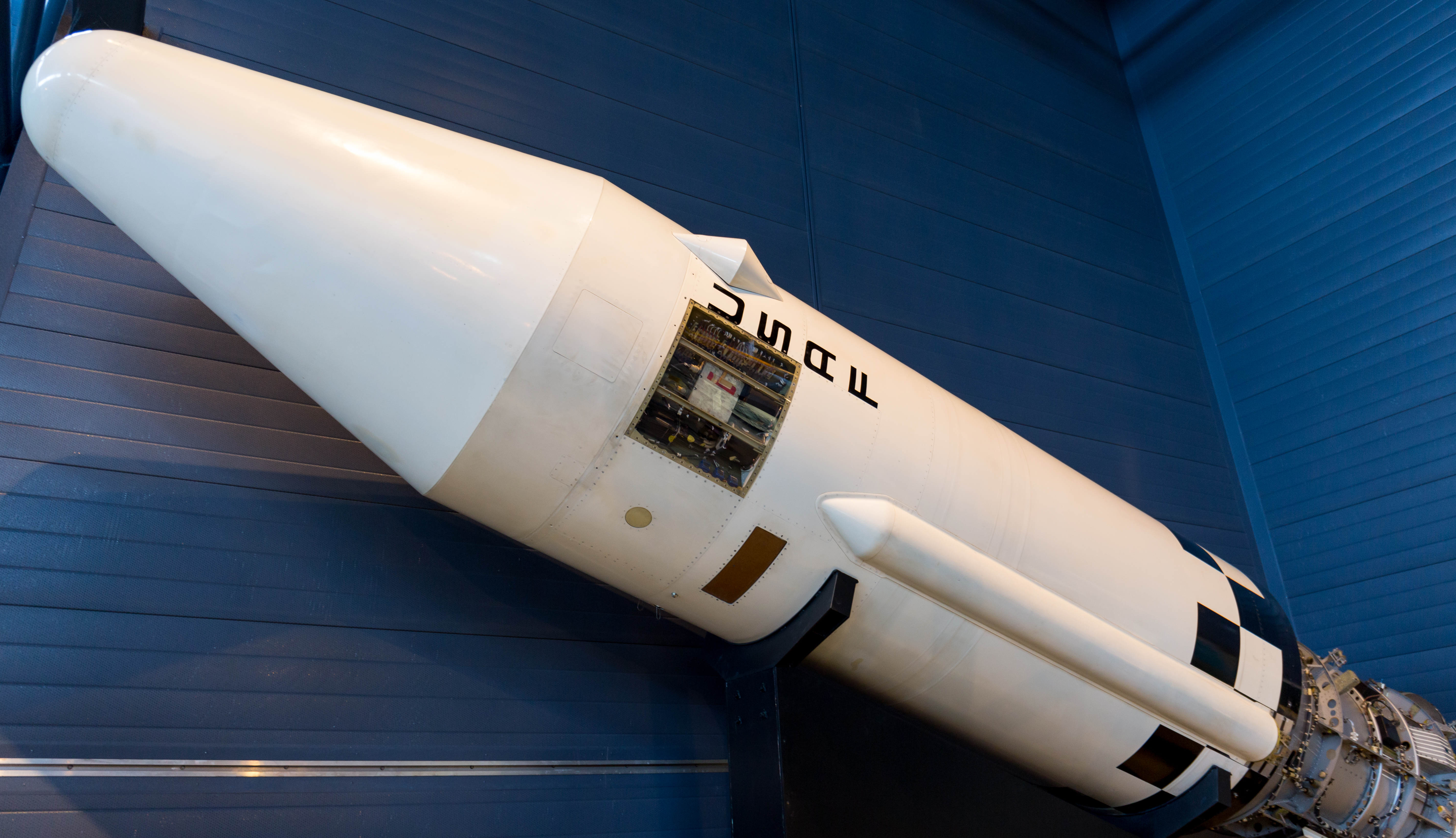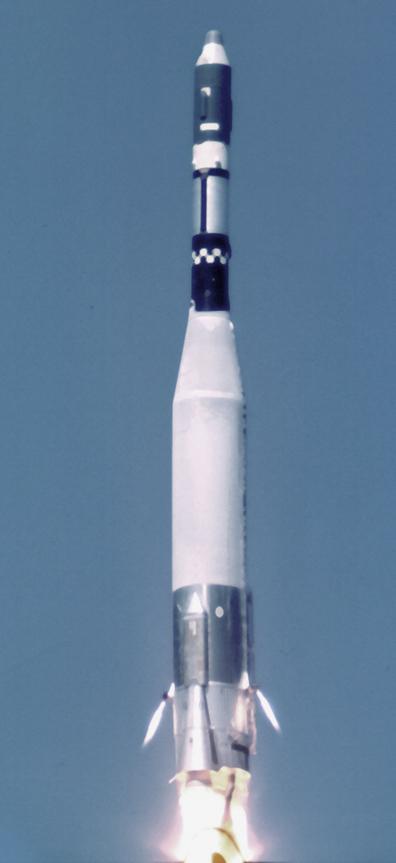|
Titan IIIB
Titan IIIB was the collective name for a number of derivatives of the Titan II ICBM and Titan III launch vehicle, modified by the addition of an Agena upper stage. It consisted of five separate rockets. The Titan-3B Agena-D was a basic Titan IIIA with an Agena D upper stage. The Titan 23B was a basic Titan II with an Agena upper stage, and the Titan 24B was the same concept, but using the slightly enlarged Titan IIIM rocket as the base. The Titan 33B was a Titan 23B with the Agena (which had a smaller diameter than the Titan) enclosed in an enlarged fairing, in order to allow larger payloads to be launched. The final member of the Titan IIIB family was the Titan 34B which was a Titan 24B with the larger fairing used on the Titan 33B. Features Part of the Titan rocket family, the Titan 23B space launch vehicle was a three-stage liquid fueled booster, designed to provide a small-to-medium weight class capability. It was able to lift approximately into a polar low-Earth circula ... [...More Info...] [...Related Items...] OR: [Wikipedia] [Google] [Baidu] |
KH-8
The KH-8 (BYEMAN codename Gambit-3) was a long-lived series of reconnaissance satellites of the "Key Hole" (KH) series used by the United States from July 1966 to April 1984, and also known as Low Altitude Surveillance Platform. The satellite ejected "film-bucket" canisters of photographic film that were retrieved as they descended through the atmosphere by parachute. Ground resolution of the mature satellite system was better than . There were 54 launch attempts of the 3,000 kilogram satellites, all from Vandenberg Air Force Base, on variants of the Titan III rocket. Three launches failed to achieve orbit. The first one was satellite #5 on April 26, 1967, which fell into the Pacific Ocean after the Titan second stage developed low thrust. The second was satellite #35 on May 20, 1972, which suffered an Agena pneumatic regulator failure and reentered the atmosphere. A few months later, pieces of the satellite turned up in England and the US managed to arrange for their hasty retu ... [...More Info...] [...Related Items...] OR: [Wikipedia] [Google] [Baidu] |
RM-81 Agena
The RM-81 Agena () was an American rocket upper stage and satellite bus which was developed by Lockheed Corporation initially for the canceled WS-117L reconnaissance satellite program. Following the division of WS-117L into SAMOS and Corona for image intelligence, and MIDAS for early warning, the Agena was later used as an upper stage, and an integrated component, for several programs, including Corona reconnaissance satellites and the Agena Target Vehicle used to demonstrate rendezvous and docking during Project Gemini. It was used as an upper stage on the Atlas, Thor, Thorad and Titan IIIB rockets, and considered for others including the Space Shuttle and Atlas V. A total of 365 Agena rockets were launched between February 28, 1959 and February 1987. Only 33 Agenas carried NASA payloads and the vast majority were for DoD programs. On some missions, the payload was built directly into the Agena, which provided it with electric power, communications and three-axis stabilizati ... [...More Info...] [...Related Items...] OR: [Wikipedia] [Google] [Baidu] |
Jumpseat (satellite)
Jumpseat, also known as AFP-711 is reportedly a code name for a class of SIGINT reconnaissance satellites operated by the National Reconnaissance Office for the United States Air Force in the 1970s and 1980s. The program is classified, and much of the information in the open is speculative. Satellites It is believed that six Jumpseat satellites were successfully launched from Vandenberg Air Force Base on Titan IIIB launch vehicles with Agena D boosters between 21 March 1971 and 31 July 1983, the primary purpose of them being to monitor Soviet ABM radars. There was one failure, when the second satellite's Agena malfunctioned and left it in a useless orbit. The 700-kg Jumpseat satellites were manufactured by Hughes Aircraft and were inserted into highly elliptical Molniya orbits with an inclination of 63 degrees and orbital periods of close to 12 hours. These were in similar orbits to the Satellite Data System relay satellites. The successors to the Jumpseat series are the Trumpe ... [...More Info...] [...Related Items...] OR: [Wikipedia] [Google] [Baidu] |
Atlas (rocket Family)
Atlas is a family of US missiles and space launch vehicles that originated with the SM-65 Atlas. The Atlas intercontinental ballistic missile (ICBM) program was initiated in the late 1950s under the Convair Division of General Dynamics. Atlas was a liquid propellant rocket burning RP-1 kerosene fuel with liquid oxygen in three engines configured in an unusual "stage-and-a-half" or "parallel staging" design: two outboard booster engines were jettisoned along with supporting structures during ascent, while the center sustainer engine, propellant tanks and other structural elements remained connected through propellant depletion and engine shutdown. The Atlas name was originally proposed by Karel Bossart and his design team working at Convair on project MX-1593. Using the name of a Atlas (mythology), mighty Titan from Greek mythology reflected the missile's place as the biggest and most powerful at the time. It also reflected the parent company of Convair, the Atlas Corporation. The ... [...More Info...] [...Related Items...] OR: [Wikipedia] [Google] [Baidu] |
KH-7 Gambit
BYEMAN codenamed GAMBIT, the KH-7 (Air Force Program 206) was a reconnaissance satellite used by the United States from July 1963 to June 1967. Like the older Corona (satellite), CORONA system, it acquired imagery intelligence by taking photographs and returning the undeveloped film to earth. It achieved a typical ground-resolution of to . Though most of the imagery from the KH-7 satellites was declassified in 2002, details of the satellite program (and the satellite's construction) remained classified until 2011. In its summary report following the conclusion of the program, the National Reconnaissance Office concluded that the GAMBIT program was considered highly successful in that it produced the first high-resolution satellite photography, 69.4% of the images having a resolution under ; its record of successful launches, orbits, and recoveries far surpassed the records of earlier systems; and it advanced the state of the art to the point where follow-on larger systems cou ... [...More Info...] [...Related Items...] OR: [Wikipedia] [Google] [Baidu] |
KH-8 Gambit 3
The KH-8 (Byeman Control System, BYEMAN codename Gambit-3) was a long-lived series of reconnaissance satellites of the "Key Hole" (KH) series used by the United States from July 1966 to April 1984, and also known as Low Altitude Surveillance Platform. The satellite ejected Corona (satellite)#Recovery, "film-bucket" canisters of photographic film that were retrieved as they descended through the Atmosphere of Earth, atmosphere by parachute. Ground resolution of the mature satellite system was better than . There were 54 launch attempts of the 3,000 kilogram satellites, all from Vandenberg Air Force Base, on variants of the Titan (rocket family)#Titan III, Titan III rocket. Three launches failed to achieve orbit. The first one was satellite #5 on April 26, 1967, which fell into the Pacific Ocean after the Titan second stage developed low thrust. The second was satellite #35 on May 20, 1972, which suffered an Agena pneumatic regulator failure and reentered the atmosphere. A few mont ... [...More Info...] [...Related Items...] OR: [Wikipedia] [Google] [Baidu] |
Project Gemini
Project Gemini () was the second United States human spaceflight program to fly. Conducted after the first American crewed space program, Project Mercury, while the Apollo program was still in early development, Gemini was conceived in 1961 and concluded in 1966. The Gemini spacecraft carried a two-astronaut crew. Ten Gemini crews and 16 individual astronauts flew low Earth orbit (LEO) missions during 1965 and 1966. Gemini's objective was the development of space travel techniques to support the Apollo mission to Moon landing, land astronauts on the Moon. In doing so, it allowed the United States to catch up and overcome the lead in human spaceflight capability the Soviet Union had obtained in the early years of the Space Race, by demonstrating mission endurance up to just under 14 days, longer than the eight days required for a round trip to the Moon; methods of performing extravehicular activity (EVA) without tiring; and the orbital maneuvers necessary to achieve space rendezv ... [...More Info...] [...Related Items...] OR: [Wikipedia] [Google] [Baidu] |
Titan I
The Martin Marietta SM-68A/HGM-25A Titan I was the United States' first multistage intercontinental ballistic missile (ICBM), in use from 1959 until 1962. Though the SM-68A was operational for only three years, it spawned numerous follow-on models that were a part of the U.S. arsenal and space launch capability. The Titan I was unique among the Titan models in that it used liquid oxygen and RP-1 as propellants; all subsequent versions used storable propellants instead. Originally designed as a backup in case the U.S. Air Force's SM-65 Atlas missile development ran into problems, the Titan was ultimately beaten into service by Atlas. Deployment went ahead anyway to more rapidly increase the number of missiles on alert and because the Titan's missile silo basing was more survivable than Atlas. The succeeding LGM-25C Titan II served in the U.S. nuclear deterrent until 1987 and had increased capacity and range in addition to the different propellants. History By January 1955, the ... [...More Info...] [...Related Items...] OR: [Wikipedia] [Google] [Baidu] |
Titan Rocket
Titan was a family of United States expendable rockets used between 1959 and 2005. The Titan I and Titan II were part of the US Air Force's intercontinental ballistic missile (ICBM) fleet until 1987. The space launch vehicle versions contributed the majority of the 368 Titan launches, including all the Project Gemini crewed flights of the mid-1960s. Titan vehicles were also used to lift US military payloads as well as civilian agency reconnaissance satellites and to send interplanetary scientific probes throughout the Solar System. Titan I missile The HGM-25A Titan I, built by the Martin Company, was the first version of the Titan family of rockets. It began as a backup ICBM project in case the SM-65 Atlas was delayed. It was a two-stage rocket operational from early 1962 to mid-1965 whose LR-87 booster engine was powered by RP-1 (kerosene) and liquid oxygen (LOX). The ground guidance for the Titan was the UNIVAC ATHENA computer, designed by Seymour Cray, based in a harden ... [...More Info...] [...Related Items...] OR: [Wikipedia] [Google] [Baidu] |







